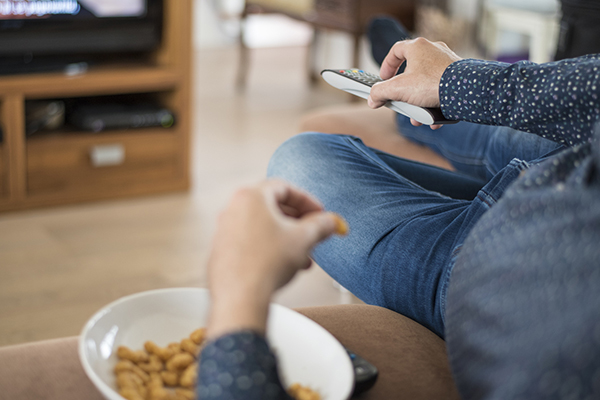5 Bad Eating Habits and How to Break Them

Killing your workouts and eating healthy meals are crucial components of healthy, sustainable weight loss.
But sometimes — even when it feels like you’re doing everything right — the scale won’t budge. What gives?
When it comes to weight loss and food, it’s not just what we eat that matters — how we eat food matters, too.
If you’re human, you’ve likely adopted some bad eating habits along the way (like polishing off an entire pint of ice cream in one sitting, *cough cough*).
We talked to the experts to break down some of the most common weight loss-sabotaging eating habits — and what to do about them.
5 Bad Eating Habits (and How to Break Them)
1. Skipping Meals
Hitting snooze a few too many times, meetings that run through your lunch hour, and last-minute plans can leave you hungry for hours on end.
And then when you do get a chance to sit down for a meal, you’re more likely to eat everything in sight.
“Many people overcompensate for skipping meals by consuming more calories than needed at the next meal,” Katy MacQueen, senior bariatric dietitian at Brigham and Women’s Hospital, says.
If you frequently forgo breakfast, know this: Research shows breakfast eaters tend to weigh less and have more success keeping the weight off.
What to do about it:
If you’re a frequent breakfast skipper, prepare healthy, delicious make-ahead breakfasts like egg cups, overnight oats, protein muffins, and energy bars so you have something to look forward to — and you don’t have to whip something up from scratch each and every morning.
If you regularly miss lunch because work and life get crazy and you forget to eat — or can’t find the time to — set a reminder.
Scheduling 20 or so minutes to sit down and enjoy your meal not only helps prevent you from missing it but also signals to coworkers that you’re busy.
But let’s be real: Sometimes it can feel like there aren’t enough hours or minutes in the day to prepare a meal, let alone eat it.
If you’re a lunch skipper, keep healthy, portable snacks on hand like energy balls, Shakeology packets, nut and seed mixes, or roasted chickpeas to tide you over until your next meal.
And if dinner is your problem, keep a meal or two of leftovers ready to go in the freezer for busy nights.

2. Going to the Grocery Store Hungry
“When we’re hungry, we’re more likely to impulse-buy foods that are high fat and high calorie,” Rose Marie Ward, Ph.D., professor of public health at Miami University, says.
A 2013 study showed that hungry subjects purchased more higher-calorie items compared to subjects who were not hungry.
Another study found that hungry people purchased more nonfood items than their non-hungry counterparts.
What to do about it:
Hungry? Don’t grab a Snickers. (And don’t go to Target.)
Rather than let your stomach do the buying, eat before you head to the grocery store.
If you don’t have time for a meal, grab a high-protein snack or a nutrient-dense shake that’ll keep you satisfied until you get home.
Another solution: “Use a shopping list and stick to it,” Ward says.
Remember that what you buy one day affects what you eat for a few days or the entire week.
One of the most effective tools to avoid eating or overeating unhealthy food is to cut back on it in the first place.
“Remove triggers or cues that remind you to eat unhealthily,” she adds.

3. Mindless Eating
When you’re eating in a hurry or while you’re distracted, chances are that you’re not paying attention to your hunger cues.
“Mindless eating reflects automated eating behaviors that have formed throughout life,” says Susan Schembre, Ph.D., R.D., and assistant professor of Behavioral Science at The University of Texas MD Anderson Cancer Center.
If you’re not paying attention to what you’re eating and how you feel in the moment, you’re more likely to overeat. Distractions — TVs, computers, phones — can make things worse.
Research suggests the likelihood of weight gain increases the more we eat while performing another activity, such as watching TV.
On a positive note, being more mindful while eating is associated with lower odds of obesity.
“Many people who eat in a hurry don’t pick optimal foods, but rather what is quick, easy, and convenient,” MacQueen adds.
Eating more slowly can substantially increase the feeling of fullness and reduce the number of calories consumed in one sitting.
What to do about it:
“You can begin to eat more mindfully by shutting off technology during meals and sitting down to focus on the meal — and the meal only,” MacQueen says.
“When you eat, just eat,” Ward suggests.
Pay attention to the food. What does it taste like? What does it feel like in your mouth? What does it smell like?
Pause and really pay attention to your food: The act of bringing awareness to these feelings is often enough to prevent overeating, Schembre says.

4. Emotional Eating
Even though the phrase “emotional eating” may conjure up sour memories of a pint of Ben & Jerry’s and a bad breakup, it doesn’t always have to apply to sadness.
Emotional eating can apply to any emotion or state that makes you eat more or reach for unhealthy comfort foods.
“We see it on TV and in books that people seek out food for comfort. It is also the first thing we think of when someone experiences a loss, like a death in the family, or a gain, like a birth in the family,” Ward says.
But feeding your emotions can have a negative impact on your weight-loss efforts: Research links emotional eating with greater food intake.
Food may serve as a coping mechanism to deal with sadness, stress, anxiety, joy, and boredom; it’s called “comfort food” for a reason.
Starting at a young age, we’re programmed to think a big bowl of ice cream or mac and cheese is more comforting than raw carrots.
Research shows that when we repeatedly “reward” ourselves with food in reaction to an emotional state, it activates the “reward and pleasure centers” in our brains.
And when that emotional state is stress, we tend to gravitate toward high-fat, high-sugar foods.
What to do about it:
“If you know you’re prone to emotional eating and you’re having a bad day, don’t surround yourself with food. Stay out of the grocery store.
Make sure your house is only stocked with healthy options,” MacQueen suggests.
Instead of defaulting to the drive-through or tearing through your entire pantry, find nonfood alternatives for dealing with negative and positive emotions.
Frustrated after sitting in traffic for hours? Cue up some Beastie Boys and go for a head-clearing run.
Finally got that promotion at work? Treat yourself to those shoes you’ve been eyeing or a massage.
Above all else, keep tempting foods out of sight and out of mind.
5. Eating Straight Out of the Bag or Box
If “once you pop, the fun don’t stop” is an all-too-real motto for you, be warned: Research shows that people tend to scarf down significantly more calories when they eat straight from large bags or boxes, rather than eating a single-serving portion.
More often than not, the portion of food you eat depends on the stopping point of whatever you’re eating, Schembre explains.
And when the physical stopping point is the bottom of the bag or box, well… enough said.
“The end is far when you’re eating chips from a huge family-size bag,” MacQueen adds.
What to do about it:
When you have less food in sight, you tend to eat less. Instead of diving straight into the bag or box, check the nutrition label to see how much a serving size is and put that amount in a small bowl or plate.
If you buy food in bulk, consider dividing it into single-serve containers before you put it away in the fridge or pantry.
Break Up With Your Bad Eating Habits
Ready to shake a bad habit or two? The first step is to recognize what’s keeping you off track.
“Eating habits, particularly those that we picked up early in life, can be really hard to break,” Schembre says. “Becoming aware of habits and understanding their roots are the first steps to breaking them.”
Try Schembre’s three-step plan:
- Be willing to admit to yourself what your habits are and don’t judge yourself negatively for them.
- Declare your intention to change that habit: To make it official, share your intention with a friend or family member or write a contract to yourself.
- Find a way to hold yourself accountable for following through with your intentions, such as a mobile or written food diary. Rather than just tracking what you eat and when, note how you feel when you eat, and how hungry you feel before and after eating.
Whatever goal you make, MacQueen suggests you follow the SMART method: “The goal should be sustainable, measurable, attainable, realistic, and have a set time frame,” she says.
Breaking bad habits takes time and diligence. Be patient and remember that healthy, sustainable weight loss requires balanced meals and exercise — not the latest quick-fix diet.
Once you make the transition to eating healthy, you’ll be on the road to improving your overall health, your relationship with food, and creating a healthy body image.
Looking for more expert tips? Head over to Beachbody On Demand and find out how Beachbody’s at-home workouts, nutrition programs, and online community work together to help you reach your health and fitness goals.
